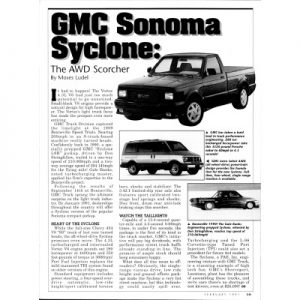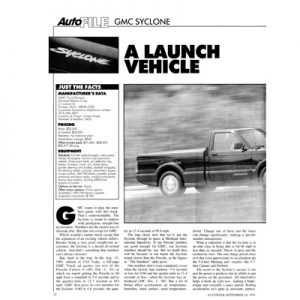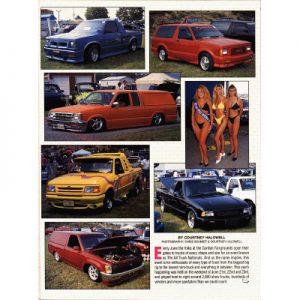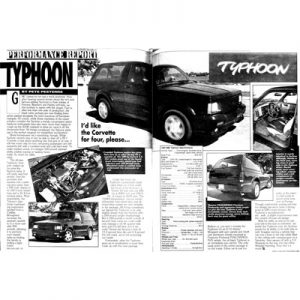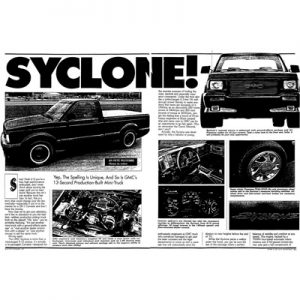Road & Track
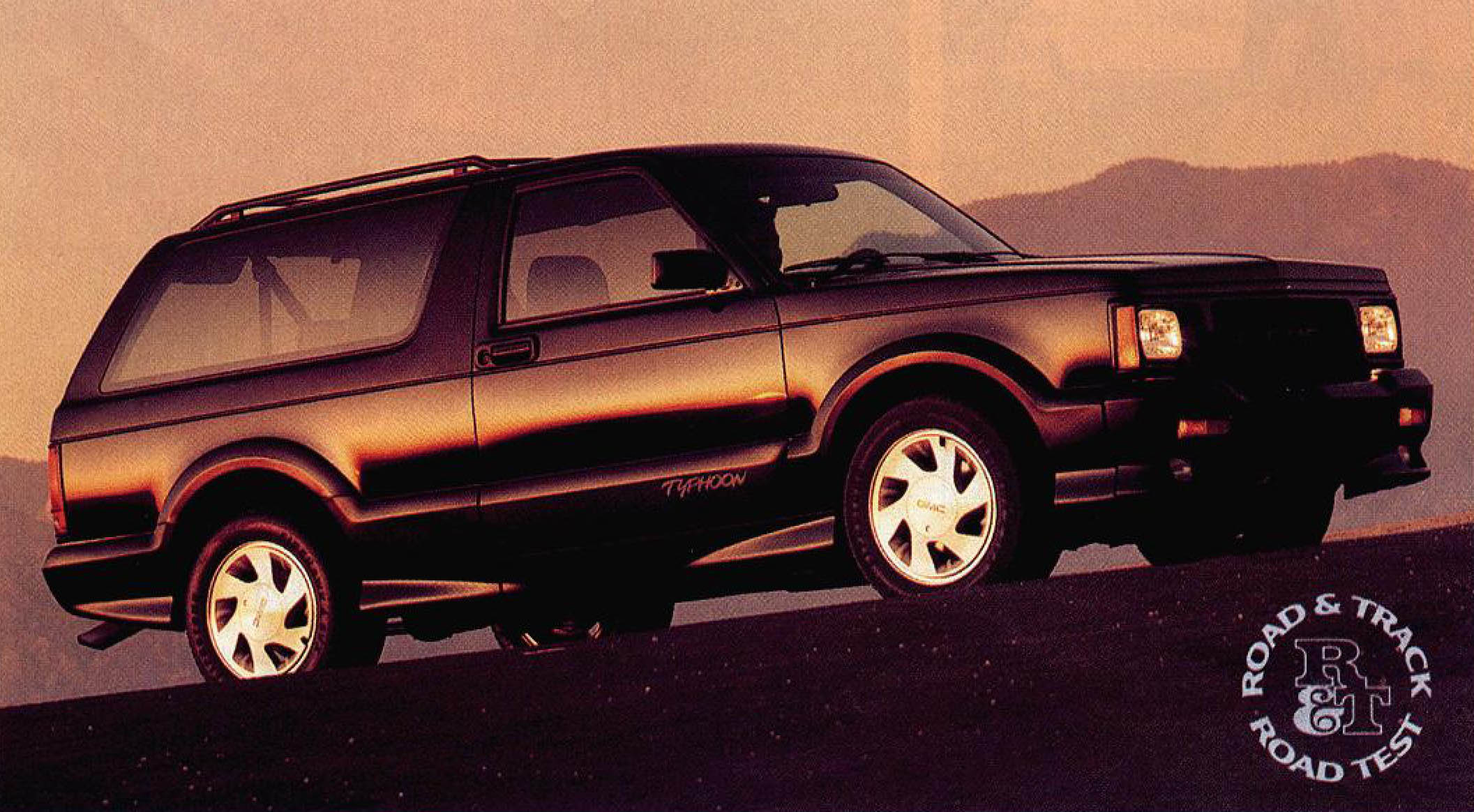
BY KEN ZINO
HERE’S THE PROPOSITION: Take a utility truck and lower the body and suspension to get that Fifties’ rod posture. Next, stuff a turbo engine in, adding some hot to rod. Don’t forget the special 16-in. alloy wheels and low-profile all-season tires to complement the all-wheel-drive chassis. Add the requisite air dams, skirts and black-out trim to make this hybrid look different from the run-of-the-mill offerings. Throw in charcoal-colored leather seating surfaces and other interior trim items, full power accessories and a decent stereo. Price it at $29,470. That’s the deal.
Typhoon is the GM truck division’s latest attempt to separate itself from those “Heartbeat” people who sell the same basic pickup and utility trucks as Chevrolet, not to mention the numerous offerings from Ford, Jeep and Dodge. From where we test it’s the fastest-accelerating utility truck in the land. It’s also one of the fastest vehicles, period, in a straight line.
The stimulation for such headway is supplied by a 90-degree, 4.3-liter V-6 engine that made its debut last year in the GMC Syclone pickup. A Mitsubishi turbocharger and water-to-air inter-cooler are added to the induction system of the Jimmy engine. The pistons, individual port fuel injectors and throttle body are borrowed from the L98 Corvette V-8.
With a maximum of 14 psi of boost allowed by the Delco Electronics computer when running on 91-octane unleaded, the V-6 produces 280 bhp, as in “brute horsepower.” Typhoon is the automotive equivalent of a Fourth of July fireworks display.
As our instrumented track times indicate, this 4×4 can launch from a green light and blow away just about anything on the street, save the odd Ferrari F40 or ZR-1 Corvette. Once you learn the subtleties of the engine-control system, that is. Hold your foot on the brake and load the engine, but don’t go all the way to the floor with the brakes on as the boost will be dumped. Wait for the chassis to shudder and twist. Left foot up, as the right one dives and the show begins. Now!
A maximum of 360 Ib.-ft. of torque is transmitted to the pavement (no off-roading allowed because of the reduced ground clearance) by way of a transfer case borrowed from the Chevrolet Astro van and a modified Hydra-matic 4L60 (old designation 700R4) transmission from the Corvette. The rear differential is a limited-slip type. Shift quality of the 4-speed automatic is only so-so. Firm engagements declare the selection of another gear or the locking of the torque converter. Underneath the Typhoon is machinery, truck machinery, and it never lets you forget it.
Torque is automatically split about 35 percent front, 65 percent rear when the Typhoon is operated on dry pavement. A viscous clutch mediates the routing of power on slippery surfaces between front and rear axles. If the front-to-rear speed differential is high, the silicone fluid between 51 clutch plates inside the viscous clutch thickens from the shearing action. This causes power to be routed to the wheels with more grip. It’s a sophisticated system with almost instantaneous response that requires no driver action to be 100 percent effective.
The Firestone V-speed-rated, all-season tires were developed especially for this application, according to GMC. With four enormous contact patches clawing the pavement and precise electronic control of spark timing and boost, our testing times were exceptionally consistent. It’s easy to drive, once you get used to some turbo lag and learn to keep the revs up.
Handling isn’t bad either, considering the unsophisticated truck ladder-frame chassis. The high center of gravity combined with the potent grip of the tires produces lots of body roll. This sudden seesawing about the longitudinal axis is intimidating at first. Not intimidating at all is the excellent outward vision from the high seating position, large windows and expansive rearview mirrors.
So take a deep breath, choose your cornering and exit lines carefully— and let it roll. Concentrate on the smoothness of your steering, throttle and brake actuations, and you’ll find the Typhoon handles solicitously. Predictable understeer and no lurching surprises during transitions make for a disporting time at speed.
There is some dissonance, alas. The weakness of the live rear axle with semielliptical springs and its considerable unsprung weight quickly become apparent on rougher surfaces. The bumping, twisting movements that result—is this why it’s called “live”? —make for a palsied course line. This, depending on your speed and IQ, ultimately compels you to back off the throttle and slow down. Now.
Here, the anti-lock braking system is always ready to help sort things out while maintaining steering control. Unlike some utility vehicles, the anti-lock system works in conjunction with the 4-wheel drive, the best of both go and whoa modes. So even though pitching is pronounced when the brakes are applied, stopping distances are good, and pedal feel and directional stability, excellent. All this from a front-disc, rear-drum system. Like the Syclone pickup that preceded Typhoon, GMC is betting it can lure enough buyers to justify a limited run of a few thousand per year. So Typhoon isn’t intended to take the market by, well, storm. Good thing, too. The immense appeal of the prodigious acceleration and reasonable handling are blunted by the inherent design disadvantages, including the loss of off-road utility, no trailer towing, and only 500 Ib. of cargo capacity. Then there’s the, gulp, formidable price.
Still interested? Owners, however non-numerous, aren’t going to see a lot of taillights in the stoplight Grand Prix, or a lot of other GMC Typhoons, for that matter.
Copyright © Hachette Filipacchi Magazines. All rights reserved.
Reprint rights granted by Hachette Filipacchi New Media on January 20, 2000.

